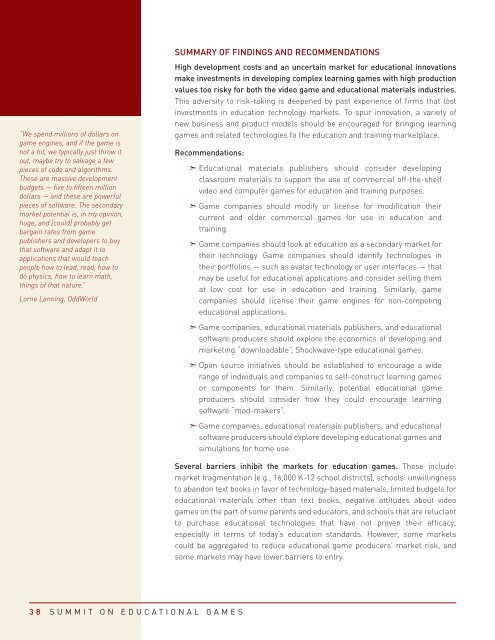Summit on Educational Games - Federation of American Scientists
Summit on Educational Games - Federation of American Scientists
Summit on Educational Games - Federation of American Scientists
You also want an ePaper? Increase the reach of your titles
YUMPU automatically turns print PDFs into web optimized ePapers that Google loves.
“We spend milli<strong>on</strong>s <strong>of</strong> dollars <strong>on</strong><br />
game engines, and if the game is<br />
not a hit, we typically just throw it<br />
out, maybe try to salvage a few<br />
pieces <strong>of</strong> code and algorithms.<br />
These are massive development<br />
budgets — five to fifteen milli<strong>on</strong><br />
dollars — and these are powerful<br />
pieces <strong>of</strong> s<strong>of</strong>tware. The sec<strong>on</strong>dary<br />
market potential is, in my opini<strong>on</strong>,<br />
huge, and [could] probably get<br />
bargain rates from game<br />
publishers and developers to buy<br />
that s<strong>of</strong>tware and adapt it to<br />
applicati<strong>on</strong>s that would teach<br />
people how to lead, read, how to<br />
do physics, how to learn math,<br />
things <strong>of</strong> that nature.”<br />
Lorne Lanning, OddWorld<br />
SUMMARY OF FINDINGS AND RECOMMENDATIONS<br />
High development costs and an uncertain market for educati<strong>on</strong>al innovati<strong>on</strong>s<br />
make investments in developing complex learning games with high producti<strong>on</strong><br />
values too risky for both the video game and educati<strong>on</strong>al materials industries.<br />
This adversity to risk-taking is deepened by past experience <strong>of</strong> firms that lost<br />
investments in educati<strong>on</strong> technology markets. To spur innovati<strong>on</strong>, a variety <strong>of</strong><br />
new business and product models should be encouraged for bringing learning<br />
games and related technologies to the educati<strong>on</strong> and training marketplace.<br />
Recommendati<strong>on</strong>s:<br />
38 SUMMIT ON EDUCATIONAL GAMES<br />
➣ Educati<strong>on</strong>al materials publishers should c<strong>on</strong>sider developing<br />
classroom materials to support the use <strong>of</strong> commercial <strong>of</strong>f-the-shelf<br />
video and computer games for educati<strong>on</strong> and training purposes.<br />
➣ Game companies should modify or license for modificati<strong>on</strong> their<br />
current and older commercial games for use in educati<strong>on</strong> and<br />
training.<br />
➣ Game companies should look at educati<strong>on</strong> as a sec<strong>on</strong>dary market for<br />
their technology. Game companies should identify technologies in<br />
their portfolios — such as avatar technology or user interfaces — that<br />
may be useful for educati<strong>on</strong>al applicati<strong>on</strong>s and c<strong>on</strong>sider selling them<br />
at low cost for use in educati<strong>on</strong> and training. Similarly, game<br />
companies should license their game engines for n<strong>on</strong>-competing<br />
educati<strong>on</strong>al applicati<strong>on</strong>s.<br />
➣ Game companies, educati<strong>on</strong>al materials publishers, and educati<strong>on</strong>al<br />
s<strong>of</strong>tware producers should explore the ec<strong>on</strong>omics <strong>of</strong> developing and<br />
marketing “downloadable”, Shockwave-type educati<strong>on</strong>al games.<br />
➣ Open source initiatives should be established to encourage a wide<br />
range <strong>of</strong> individuals and companies to self-c<strong>on</strong>struct learning games<br />
or comp<strong>on</strong>ents for them. Similarly, potential educati<strong>on</strong>al game<br />
producers should c<strong>on</strong>sider how they could encourage learning<br />
s<strong>of</strong>tware “mod-makers”.<br />
➣ Game companies, educati<strong>on</strong>al materials publishers, and educati<strong>on</strong>al<br />
s<strong>of</strong>tware producers should explore developing educati<strong>on</strong>al games and<br />
simulati<strong>on</strong>s for home use.<br />
Several barriers inhibit the markets for educati<strong>on</strong> games. These include:<br />
market fragmentati<strong>on</strong> (e.g., 16,000 K-12 school districts), schools’ unwillingness<br />
to aband<strong>on</strong> text books in favor <strong>of</strong> technology-based materials, limited budgets for<br />
educati<strong>on</strong>al materials other than text books, negative attitudes about video<br />
games <strong>on</strong> the part <strong>of</strong> some parents and educators, and schools that are reluctant<br />
to purchase educati<strong>on</strong>al technologies that have not proven their efficacy,<br />
especially in terms <strong>of</strong> today’s educati<strong>on</strong> standards. However, some markets<br />
could be aggregated to reduce educati<strong>on</strong>al game producers’ market risk, and<br />
some markets may have lower barriers to entry.
















